Abstract
Purpose
With the increasing use of imaging, there has been an increase in the number of incidentally found brain lesions in pediatric patients resulting in a treatment dilemma for physicians and emotional strain for patients and families. Adult studies support initial surveillance of incidentally found low grade appearing lesions as the most appropriate approach. The aim of this study was to evaluate incidental lesions in the pediatric population and propose an initial treatment algorithm for such lesions.
Methods
Pediatric records were retrospectively reviewed at Johns Hopkins All Children’s Hospital for incidentally found brain tumors between 2000 and 2017. Demographic data, presenting symptoms, treatment approach, and outcomes were reviewed for 55 patients, age 0–18.
Results
Of the 55 patients included in the study, 14 underwent surgical resection, 3 underwent biopsy, and 38 with benign imaging characteristics at presentation were monitored with radiology alone. Only one patient, out of the 17 that underwent resection or biopsy, had pathology consistent with a high grade glioma. Of the patients monitored radiographically 10 total patients showed an increase in the overall size of the lesion; however after a median follow up of 34.2 months only 2 increased to a degree that required surgical intervention.
Conclusions
The majority of incidentally found brain lesions with benign imaging characteristics at presentation may be managed conservatively. Surveillance is an important part of the initial management of incidental lesions in the pediatric population, but careful scrutiny must be paid to the potential for higher grade lesions or malignant transformation.

Similar content being viewed by others
References
Perret C et al (2011) Incidental findings of mass lesions on neuroimages in children. Neurosurg Focus 31(6):E20
Pollack IF (1999) The role of surgery in pediatric gliomas. J Neurooncol 42(3):271–288
Potts MB et al (2012) Natural history and surgical management of incidentally discovered low-grade gliomas. J Neurosurg 116(2):365–372
Shah AH et al (2011) The management of incidental low-grade gliomas using magnetic resonance imaging: systematic review and optimal treatment paradigm. Neurosurg Focus 31(6):E12
Duffau H (2013) The rationale to perform early resection in incidental diffuse low-grade glioma: toward a “preventive surgical neurooncology”. World Neurosurg 80(5):e115–e117
Di Rocco C, Frassanito P, Tamburrini G (2014) The never-ending struggle between the two souls of the neurosurgeon: to wait or to intervene. World Neurosurg 81(2):268–270
Bredlau AL et al (2012) Incidental brain lesions in children: to treat or not to treat? J Neurooncol 106(3):589–594
Roth J et al (2012) Pediatric incidental brain tumors: a growing treatment dilemma. J Neurosurg Pediatr 10(3):168–174
Ali ZS, Lang SS, Sutton LN (2014) Conservative management of presumed low-grade gliomas in the asymptomatic pediatric population. World Neurosurg 81(2):368–373
Louis DN et al (2016) The 2016 World Health Organization classification of tumors of the central nervous system: a summary. Acta Neuropathol 131(6):803–820
Ellison DW et al (2011) Histopathological grading of pediatric ependymoma: reproducibility and clinical relevance in European trial cohorts. J Negat Results Biomed 10:7
Verstappen CC et al (2003) Neurotoxic complications of chemotherapy in patients with cancer: clinical signs and optimal management. Drugs 63(15):1549–1563
Merchant TE et al (2009) Late effects of conformal radiation therapy for pediatric patients with low-grade glioma: prospective evaluation of cognitive, endocrine, and hearing deficits. J Clin Oncol 27(22):3691–3697
Shafqat S, Hedley-Whyte ET, Henson JW (1999) Age-dependent rate of anaplastic transformation in low-grade astrocytoma. Neurology 52(4):867–869
Broniscer A (2006) Past, present, and future strategies in the treatment of high-grade glioma in children. Cancer Invest 24(1):77–81
Broniscer A (2015) Malignant transformation of low-grade gliomas in children: lessons learned from rare medical events. J Clin Oncol 33(9):978–979
Dolecek TA et al (2012) CBTRUS statistical report: primary brain and central nervous system tumors diagnosed in the United States in 2005–2009. Neuro Oncol 14(Suppl 5):v1–v49
Fangusaro J (2012) Pediatric high grade glioma: a review and update on tumor clinical characteristics and biology. Front Oncol 2:105
Jagadeesh H, Bernstein M (2014) Patients’ anxiety around incidental brain tumors: a qualitative study. Acta Neurochir (Wien) 156(2):375–381
Broniscer A et al (2007) Clinical and molecular characteristics of malignant transformation of low-grade glioma in children. J Clin Oncol 25(6):682–689
Mistry M et al (2015) BRAF mutation and CDKN2A deletion define a clinically distinct subgroup of childhood secondary high-grade glioma. J Clin Oncol 33(9):1015–1022
la Fougère C et al (2011) Molecular imaging of gliomas with PET: opportunities and limitations. Neuro Oncol 13(8):806–819
Pirotte BJ et al (2010) Clinical interest of integrating positron emission tomography imaging in the workup of 55 children with incidentally diagnosed brain lesions. J Neurosurg Pediatr 5(5):479–485
Author information
Authors and Affiliations
Corresponding author
Ethics declarations
Conflict of interest
No authors have any conflict of interest to report.
Ethical approval
All procedures performed in studies involving human participants were in accordance with the ethical standards of the institutional and/or national research committee and with the 1964 Helsinki declaration and its later amendments or comparable ethical standards.
Electronic supplementary material
Below is the link to the electronic supplementary material.
Rights and permissions
About this article
Cite this article
Wright, E., Amankwah, E.K., Winesett, S.P. et al. Incidentally found brain tumors in the pediatric population: a case series and proposed treatment algorithm. J Neurooncol 141, 355–361 (2019). https://doi.org/10.1007/s11060-018-03039-1
Received:
Accepted:
Published:
Issue Date:
DOI: https://doi.org/10.1007/s11060-018-03039-1




